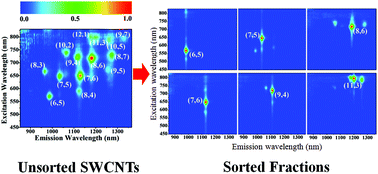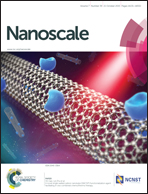Ethanol-assisted gel chromatography for single-chirality separation of carbon nanotubes†
Abstract
Surfactants or polymers are usually used for the liquid processing of carbon nanotubes for their structure separation. However, they are difficult to remove after separation, affecting the intrinsic properties and applications of the separated species. Here, we report an ethanol-assisted gel chromatography for the chirality separation of single-walled carbon nanotubes (SWCNTs), in which ethanol is employed to finely tune the density/coverage of sodium dodecyl sulfate (SDS) on nanotubes, and thus the interactions between SWCNTs and an allyl dextran-based gel. Incrementally increasing the ethanol content in a low-concentration SDS eluent leads to successive desorption of the different structure SWCNTs adsorbed on the gel, and to achieve multiple distinct (n, m) single-chirality species. The use of ethanol enables the working concentration of SDS to be reduced dramatically and also avoids the introduction of other surfactants or chemical reagents. More importantly, ethanol can be easily removed after separation. The ability of ethanol to tune the interactions between SWCNTs and the gel also gives a deeper insight into the separation mechanism of SWCNTs using gel chromatography.


 Please wait while we load your content...
Please wait while we load your content...